
International Journal of Corrosion and Scale Inhibition
Scope & Guideline
Unveiling Insights into Corrosion Dynamics
Introduction
Aims and Scopes
- Corrosion Mechanisms and Behavior:
The journal extensively covers studies related to the mechanisms of corrosion in different environments, including acidic, alkaline, and saline conditions, as well as the behavior of various metals and alloys under these conditions. - Development of Corrosion Inhibitors:
A core focus is on the synthesis, characterization, and evaluation of new corrosion inhibitors, including both traditional and eco-friendly options, such as plant extracts and pharmaceutical compounds. - Surface Modification Techniques:
Research on advanced surface modification techniques, including superhydrophobic coatings, conversion coatings, and polymer-based protections, is a significant area of publication. - Electrochemical Analysis:
The journal emphasizes the use of electrochemical methods for studying corrosion processes and the effectiveness of inhibitors, including techniques like electrochemical impedance spectroscopy (EIS) and potentiodynamic polarization. - Green Chemistry and Eco-Friendly Solutions:
There is a notable emphasis on the development and application of green corrosion inhibitors derived from natural sources, reflecting a commitment to sustainability in corrosion management.
Trending and Emerging
- Eco-Friendly Corrosion Inhibitors:
There is a significant rise in research dedicated to eco-friendly and green corrosion inhibitors, particularly those derived from plant extracts and natural products, reflecting a growing awareness of environmental impacts. - Nanotechnology in Corrosion Protection:
Increasing attention is given to nanomaterials and their applications in corrosion inhibition, including the use of nanoparticles and nanocomposites to enhance protective coatings. - Computational Methods in Corrosion Studies:
Recent publications show an increasing trend in the use of computational methods, such as DFT (Density Functional Theory) and molecular dynamics, to predict the effectiveness of corrosion inhibitors and understand their mechanisms. - Multifunctional Coatings:
The development of multifunctional coatings that provide both corrosion protection and additional functionalities, such as self-healing properties or antibacterial effects, is gaining traction in recent research. - Synergistic Effects of Inhibitors:
Research exploring the synergistic effects of combinations of inhibitors or additives is trending, emphasizing the complexity of corrosion processes and the potential for enhanced protection through multi-component systems.
Declining or Waning
- Traditional Inorganic Corrosion Inhibitors:
There has been a noticeable decrease in the publication of studies focused on traditional inorganic inhibitors, such as chromates and phosphates, likely due to increasing regulatory restrictions and a shift towards more environmentally friendly alternatives. - Corrosion in Marine Environments:
Research specifically targeting corrosion issues in marine environments has become less prominent, possibly as attention shifts to other industrial applications or more general corrosion mechanisms. - Basic Theoretical Studies:
The journal has seen a reduction in purely theoretical studies without experimental validation, as the trend moves towards integrated experimental and computational approaches that provide more comprehensive insights.
Similar Journals
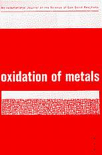
OXIDATION OF METALS
Pioneering Research on Metal ResistanceOXIDATION OF METALS, published by SPRINGER/PLENUM PUBLISHERS, stands as a pivotal journal in the fields of Inorganic Chemistry, Materials Chemistry, and Metals and Alloys. Established in 1969, it has consistently contributed to advancing knowledge and research on the oxidation processes in metals, essential for various industrial applications and theoretical frameworks. With an impact factor that reflects its respected position—ranked Q2 in key scientific categories—this journal facilitates cutting-edge discourse among researchers and practitioners alike. The journal is committed to open access, ensuring that groundbreaking research on metals’ behavior and resistance to oxidation is available to a broader audience, enhancing collaboration and innovation. Spanning over five decades, OXIDATION OF METALS continues to be a crucial resource for scholars and professionals aiming to stay at the forefront of materials science and engineering.

Analytical & Bioanalytical Electrochemistry
Pioneering Research in Electrochemical AnalysisAnalytical & Bioanalytical Electrochemistry is a pivotal journal dedicated to the advancement of research and innovation in the fields of analytical chemistry and electrochemistry. Published by the University of Tehran, Faculty of Chemistry, Center of Excellence in Electrochemistry, this journal has been contributing to the scientific community since its inception in 2009 and continues to be a critical platform through 2024. With an ISSN of 2008-4226, it focuses on a variety of topics including electrochemical sensors, bioanalytical techniques, and innovative methodologies in electrochemical analysis. Although it currently holds a Q4 quartile ranking in both analytical chemistry and electrochemistry categories, its unique insights and research findings are essential for advancing knowledge and fostering interdisciplinary collaboration within the scientific community. Researchers, professionals, and students engaged in these dynamic fields will find valuable resources and contribute to the ongoing discourse by publishing their work in this journal. We invite you to explore and engage with the diverse content that Analytical & Bioanalytical Electrochemistry offers to enhance your research and professional development.
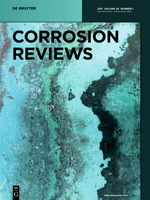
CORROSION REVIEWS
Pioneering Reviews in Corrosion ResearchCORROSION REVIEWS, published by WALTER DE GRUYTER GMBH in Germany, is a pivotal journal dedicated to advancing the understanding and management of corrosion phenomena across various fields including Chemical Engineering, Chemistry, and Materials Science. With an ISSN of 0334-6005 and an E-ISSN of 2191-0316, this esteemed journal has demonstrated an enduring commitment to scholarly excellence since its inception in 1979, encompassing comprehensive interdisciplinary research outputs and reviews. Ranked in the Q2 category across several disciplines for 2023, and positioned favorably in Scopus rankings—#94 in Chemical Engineering and #145 in Chemistry—it serves as an essential resource for researchers and professionals seeking to enhance their knowledge and application of corrosion science. While the journal does not currently offer open access, its rigorous peer-review process ensures high-quality, credible research publications that contribute significantly to the academic community's efforts in corrosion prevention and policy. Researchers, students, and industry professionals alike will find CORROSION REVIEWS an indispensable tool for staying at the forefront of this critical area of study.
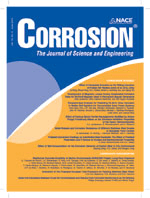
CORROSION
Pioneering Research in Corrosion and Materials ScienceCORROSION is a prestigious journal published by the Natal Association of Corrosion Engineers, dedicated to advancing the understanding of corrosion phenomena in various materials across multiple industries. With a strong commitment to high-quality research, it has established itself as a key resource in the fields of Chemical Engineering, Chemistry, and Materials Science, as reflected in its Q3 ranking in the 2023 category quartiles. This journal, retaining its relevance since 1969, serves as a platform for innovative studies and findings that address fundamental and applied aspects of corrosion, vital for professionals engaged in material selection and integrity management. Through access to state-of-the-art research, CORROSION significantly contributes to the safety, sustainability, and efficiency of engineering practices worldwide. Researchers, professionals, and students alike can benefit from the insights offered by this journal, driving forward the quest for innovative solutions in corrosion management.
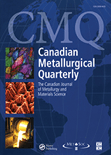
CANADIAN METALLURGICAL QUARTERLY
Shaping Tomorrow's Metallurgical Innovations Today.Canadian Metallurgical Quarterly is a prestigious scholarly journal published by Taylor & Francis Ltd, dedicated to the field of metallurgical engineering and materials science. With a rich history dating back to its inception in 1962 and continuing through its most recent publications, this journal serves as a vital platform for the dissemination of innovative research, advancements, and critical reviews in metallurgy, metals, and alloys. Positioned strategically within the academic community, it holds a significant impact factor and is currently rated in the Q2 category for Metals and Alloys, and Q3 in Industrial and Manufacturing Engineering as of 2023, showcasing its authoritative role in these disciplines. Although it does not offer open access, the journal remains widely recognized for its rigorous peer-review process, ensuring that published work adheres to the highest standards of scientific quality. Researchers, professionals, and students alike will find invaluable insights and contributions that drive the field forward.

RARE METALS
Pioneering Research in Materials ExcellenceRARE METALS is a prestigious journal at the forefront of materials science, dedicated to advancing the understanding of metallic materials and their applications. Published by the Nonferrous Metals Society of China, this journal has established itself as a leading platform for cutting-edge research in areas including condensed matter physics, materials chemistry, metals and alloys, and physical and theoretical chemistry. With an impressive impact factor and consistently ranked within the Q1 quartile across multiple categories, RARE METALS ranks highly on Scopus, illustrating its significant contribution to the field—such as a remarkable rank of 11/176 in Materials Science for Metals and Alloys and 23/434 in Condensed Matter Physics. Although it operates under a subscription model, its rigorous peer-review process ensures that only the most impactful research is published, making it an essential resource for researchers, professionals, and students engaged in material innovation. Join the global network of materials science by contributing to or exploring the wealth of knowledge RARE METALS offers, fostering advancements in areas vital for technological progress and industrial applications.

International Journal of Electrochemical Science
Exploring the electrochemical landscape of tomorrow.International Journal of Electrochemical Science is a peer-reviewed journal dedicated to disseminating cutting-edge research in the field of electrochemistry. Published by Elsevier in Serbia, this journal serves as a vital platform for scientists and researchers to explore innovative electrochemical techniques, processes, and applications. With an ISSN of 1452-3981, it has been a respected source of scholarly articles since its inception in 2006 and continues to bridge the gap between theoretical advancements and practical implementations up until 2024. Notably, it holds a Q4 quartile ranking in the field of electrochemistry and ranks 41 out of 60 in the Scopus database, situating it within the 32nd percentile among its peers. The journal champions open academic discourse, contributing significantly to the advancement of knowledge in electrochemical sciences, making it an essential resource for researchers, professionals, and students alike who are striving towards new discoveries and innovations.
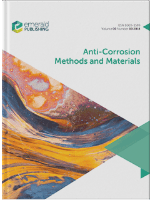
ANTI-CORROSION METHODS AND MATERIALS
Elevating Standards in Corrosion ControlANTI-CORROSION METHODS AND MATERIALS, published by EMERALD GROUP PUBLISHING LTD, is a leading journal in the fields of chemical engineering and materials science, focusing on innovative methods and materials for corrosion prevention and control. With its ISSN 0003-5599 and E-ISSN 1758-4221, this esteemed journal has been contributing to the academic community since its inception in 1954 and continues to be relevant through 2024. Despite its Q3 ranking in both Chemical Engineering and Materials Science categories, the journal plays a critical role in disseminating valuable insights and advancements, catering to a diverse audience of researchers, professionals, and students. Although the journal does not offer open access options, it remains a significant resource for those seeking to enhance their understanding of corrosion methodologies and to implement best practices in various industrial applications. With the recent Scopus rankings reflecting its impact, ANTI-CORROSION METHODS AND MATERIALS stands as a pivotal element of scholarly discourse in mitigating corrosion challenges in modern materials.
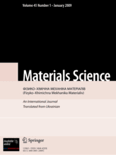
MATERIALS SCIENCE
Exploring Breakthroughs in Materials Research.MATERIALS SCIENCE, a prominent journal published by SPRINGER, serves as a vital resource for researchers, professionals, and students in the fields of materials science, mechanical engineering, and condensed matter physics. With its ISSN 1068-820X and E-ISSN 1573-885X, this journal has been dedicated to sharing innovative research since its inception in 1993, and it continues to publish groundbreaking findings through 2024. Although it operates as a traditional subscription-based journal, its ranking in the Q3 quartile across multiple scientific categories, including Condensed Matter Physics, Materials Science, Mechanical Engineering, and Mechanics of Materials, signifies its relevance and impact in the academic community. Notably, its Scopus classifications reveal a competitive standing among its peers, ranking within the 25th to 33rd percentiles across various engineering and physics disciplines. The journal remains a key platform for disseminating valuable insights, fostering collaboration, and advancing the understanding of materials science.
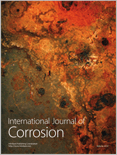
International Journal of Corrosion
Transforming Materials Science Through Corrosion ResearchInternational Journal of Corrosion is a distinguished peer-reviewed journal published by HINDAWI LTD, focusing on the critical field of corrosion research, a vital aspect of materials science and chemical engineering. Since becoming an Open Access journal in 2010, it has provided a platform for disseminating pivotal findings related to corrosion mechanisms, prevention strategies, and innovative materials designed to counteract corrosion, thus directly impacting industries ranging from construction to energy. The journal boasts a respectable impact reflected in its Scopus rankings, holding a Q3 quartile in both Materials Science and Process Chemistry and Technology, with commendable rankings of #157 out of 463 and #37 out of 73, respectively. By fostering knowledge exchange and collaboration among researchers, professionals, and students, the International Journal of Corrosion plays an essential role in advancing the understanding of corrosion phenomena, thereby contributing significantly to the development of more resilient materials and sustainable engineering practices.